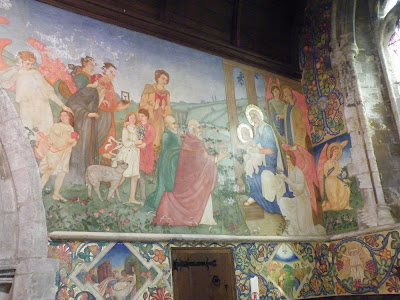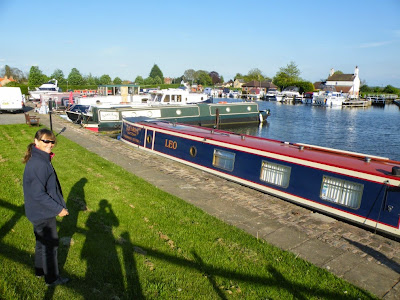Last Thursday we went up the final 23 locks from Shireoaks to Kiveton to reach the navigable limit of the Chesterfield. This final flight was a sheer delight - narrow locks which all work, no shortage of water and fine rural scenery with distant views. After the first 8 locks there is a double staircase and, after another single lock, a second double staircase. Near the top there are two triple staircases. All in all, a heap of fun and we had lovely weather both up, and later coming down.
This is Leo in Lock 40 which is one of the singles in the early part of the lock flight. You can just see Helen on her Brompton going up to set the next lock while Ian and Leo manage this one.
And here is the first of the double staircase locks. For those not versed in boating terminology a staircase is where the top gate of one lock is the bottom gate of the next: there is no gap between the locks.
Part way up we stopped for coffee and came across two swans nesting. You can see the eggs in the nest here, while the sitter is intent on rearranging the vegetation. Locals told us this pair have never raised a brood and they did desert the eggs entirely for half an hour or more. Perhaps just not very good parents.
Here is the lower of the two triples, with Helen getting it ready for Leo to come in.
Helen likes doing the locks, though we do get flack for her doing the man's work rather than Ian. Here she is 'lockwheeling' with the Brompton, carrying the windlass.
Leo in this picture is in the middle lock of the top Triple Staircase.
And here is Leo coming down on Tuesday this week in the top double staircase. In the foreground is a little bridge across the overflow from the bottom lock.
Once up the top there is a summit level of about two miles to where the Norwood Tunnel once carried on towards Chesterfield. The tunnel collapsed in 1907 and restoration plans will use only the first part of the tunnel before locks lead the canal up to a higher level.
We have been looking forward to seeing woods full of bluebells. At the top of the Chesterfield it was different with woods full of wild garlic in flower. Quite a heady scent when the wind blew it in our direction.
A few hundred yards before the tunnel is the last winding hole. It has a cascade coming in which presumably provides much of the water for the canal.
Seen from the towpath above you can see the bricked up entrance to Norwood Tunnel. Interestingly the tunnel went across land where there was also a coal mine with several shafts.
Here is Leo moored just before the winding hole. There is a station at Kiveton Park, only three minutes walk away, which was very handy for getting down to Bristol.
From the top we had a short cycle ride round neighbouring villages and found this splendid Norman doorway on the church at Thorpe Salvin:
This is Osberton Hall, a rather fine house close by the Canal near the lock of the same name.
We are always fascinated by the parenting skills of geese. Young from several families are often looked after in a 'creche' by a few adults. Just like humans in fact.
This is the view back from West Retford Lock. You would never guess you were on the edge of a substantial town.
As we came out of Retford yesterday a couple of terns were following us and diving in the canal in our wake to catch fish. This one is just about to dive and you can see it carefully locating its target. We saw several fish caught in this way.
We have a very slight but persistent diesel leak and you can see Ian having another go at trying to cure this. The curious bump on Ian's head dates back to a car accident when he was a teenager. Nothing to do with narrowboating!
When this rain stops (it is now coming down even harder than when I started typing this) we will be moving on back to West Stockwith where the Chesterfield Canal meets the tidal River Trent. I have this morning booked our passage on the Trent for Saturday afternoon when hopefully we will not go aground or be swept out to sea but will calmly and happily cruise up river to Torksey for the next part of our adventures this year. We'll be going along the Fossdyke, a navigation which dates back to the Emperor Hadrian in AD 120. We'll be heading for Lincoln and Boston, so more flat country.
Thanks to those who made comments on our last posting. We certainly did enjoy the final 23 locks as we hope this posting shows. Do come and try the Chesterfield Canal. We've enjoyed every mile of it and it will remain one of our favourite canals. We will probably be back.




































































